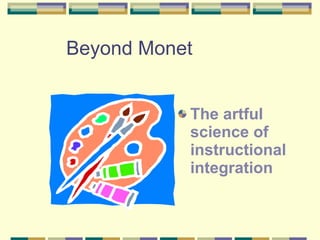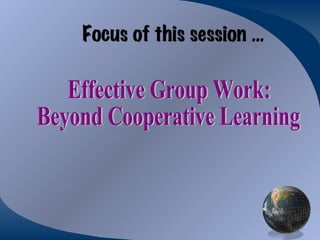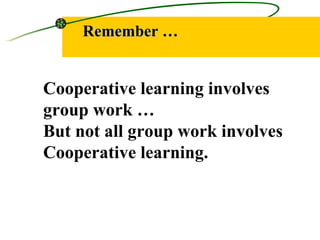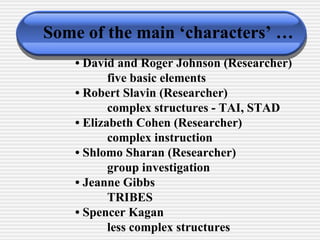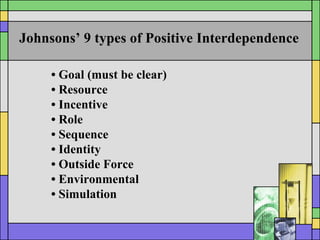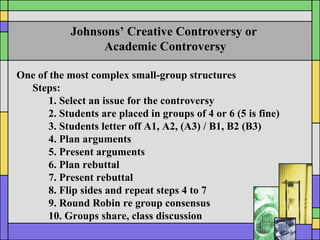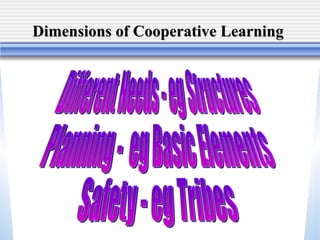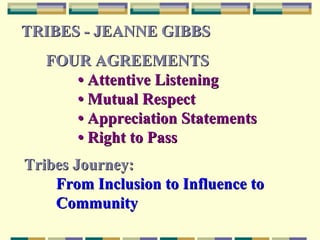Cooplearning
- 1. Beyond Monet The artful science of instructional integration
- 2. Effective Group Work: Beyond Cooperative Learning Focus of this session âĶ
- 3. Cooperative learning involves group work âĶ But not all group work involves Cooperative learning. Remember âĶ
- 4. Some of the main âcharactersâ âĶ âĒ David and Roger Johnson (Researcher) five basic elements âĒ Robert Slavin (Researcher) complex structures - TAI, STAD âĒ Elizabeth Cohen (Researcher) complex instruction âĒ Shlomo Sharan (Researcher) group investigation âĒ Jeanne Gibbs TRIBES âĒ Spencer Kagan less complex structures
- 5. Johnsonsâ Five Basic Elements âĒ individual accountability âĒ promoting face to face interaction âĒ teaching collaborative skills âĒ processing academic and collaborative objectives âĒ applying one or more of the 9 types of positive interdependence
- 6. Johnsonsâ 9 types of Positive Interdependence âĒ Goal (must be clear) âĒ Resource âĒ Incentive âĒ Role âĒ Sequence âĒ Identity âĒ Outside Force âĒ Environmental âĒ Simulation
- 7. Johnsonsâ Creative Controversy or Academic Controversy One of the most complex small-group structures Steps: 1. Select an issue for the controversy 2. Students are placed in groups of 4 or 6 (5 is fine) 3. Students letter off A1, A2, (A3) / B1, B2 (B3) 4. Plan arguments 5. Present arguments 6. Plan rebuttal 7. Present rebuttal 8. Flip sides and repeat steps 4 to 7 9. Round Robin re group consensus 10. Groups share, class discussion
- 8. A consideration âĶ Cooperative learning is not an instructional strategy; rather, it is a way of thinking that supports students working in peer-mediated groups. It represents one of three approaches to classroom work. The other two are having students working individually or competitively. These three possibilities (cooperative, individual and competitive) represent the science of teaching. The art of teaching is deciding which of the three (or combinations of the three) are the most powerful in increasing the life chances and learning chances of students.
- 9. Possibilities Is it possible for what we know about brain research, multiple intelligences, the Johnsonsâ 5 basic elements, how to frame questions, safety, accountability, fish bone diagram, place mat, one stay rest stay, checking for understanding, round robin, numbered heads, inductive thinking, Bloomâs taxonomy etc., to be integrated in say a 45 minute opportunity to learn?
- 10. How complex is simplicity ? Take âThink Pair Shareâ for example -- two students taking time to first think, then share with each other, then to share with the class -- what are all the things a teacher should consider if Think Pair Share is going to be effective?
- 11. What the university students said âĶ Is there an odd or even number of students? Who will work with the âoddâ person? Who works with the student no one wants to work with? Will boys sit beside girls? If so, will they talk? Can they actively listen? Can they paraphrase? Can the teacher frame questions effectively? How much wait time will the students get? Can the teacher âplayâ with a taxonomy of thinking? Can you respond to students responses: a ânoâ response, incorrect response, partially correct, a guess, a convoluted response, or a correct response?
- 12. Dimensions of Cooperative Learning Different Needs - eg Structures Planning - eg Basic Elements Safety - eg Tribes
- 13. There are about 300 small group structures âĶ How many can you identify in one minute?
- 14. Structures âĶ simple to more complex âĒ numbered heads (Kagan) âĒ think pair share (Lyman) âĒ three person interview (Kagan) âĒ teams games tournament (de Vries) âĒ jigsaw (Aronson) âĒ academic controversy (Johnsons) âĒ group investigation (Thelan)
- 15. How are all the things in this bowl the same? âĒ Multiple Intelligence âĒ Learning Styles Literature âĒ Child Development Literature âĒ Motivation Research âĒ Students âĒ at Risk Literature âĒ Research on students with Autism âĒ Research on gender and literacy
- 16. How are these different from the previous grouping? âĒ Mind Mapping âĒ Concept Attainment âĒ Jigsaw âĒ Group Investigation âĒ Reading Recovery âĒ Concept Mapping âĒ Academic Controversy
- 17. âĒ Mind Mapping âĒ Concept Attainment âĒ Jigsaw âĒ Group Investigation âĒ Reading Recovery âĒ Concept Mapping âĒ Academic Controversy âĒ Multiple Intelligence âĒ Learning Styles Literature âĒ Child Development Literature âĒ Motivation Research âĒ Students âĒ at Risk Literature âĒ Research on students with Autism âĒ Research on gender and literacy What is their relationship?
- 18. TRIBES - JEANNE GIBBS FOUR AGREEMENTS âĒ Attentive Listening âĒ Mutual Respect âĒ Appreciation Statements âĒ Right to Pass Tribes Journey: From Inclusion to Influence to Community
